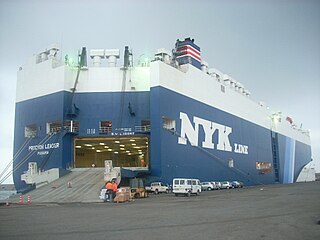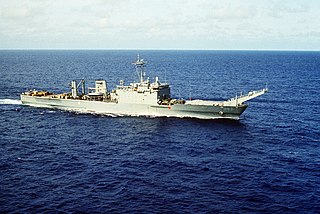
The Albion-class landing platform dock is a class of amphibious warfare ship in service with the Royal Navy. The class consists of two vessels, HMS Albion and HMS Bulwark, ordered in 1996 to replace the ageing Fearless class. Both ships were built by BAE Systems Marine at the former Vickers Shipbuilding and Engineering yard in Barrow-in-Furness. Albion was commissioned in 2003 and Bulwark in 2004. Each of the ships has a crew of 325 and can accommodate up to 405 troops. Thirty-one large trucks and thirty-six smaller vehicles and main battle tanks can be carried inside the vehicle deck. To disembark troops and vehicles, the vessels are equipped with eight landing craft.

Landing craft are small and medium seagoing watercraft, such as boats and barges, used to convey a landing force from the sea to the shore during an amphibious assault. The term excludes landing ships, which are larger. Production of landing craft peaked during World War II, with a significant number of different designs produced in large quantities by the United Kingdom and United States.

Landing Ship, Tank (LST), or tank landing ship, is the naval designation for ships first developed during World War II (1939–1945) to support amphibious operations by carrying tanks, vehicles, cargo, and landing troops directly onto a low slope beach with no docks or piers. The shallow draft and bow doors and ramps enabled amphibious assaults on almost any beach.

Roll-on/roll-off ships are cargo ships designed to carry wheeled cargo, such as cars, motorcycles, trucks, semi-trailer trucks, buses, trailers, and railroad cars, that are driven on and off the ship on their own wheels or using a platform vehicle, such as a self-propelled modular transporter. This is in contrast to lift-on/lift-off (LoLo) vessels, which use a crane to load and unload cargo.

USS Frederick (LST-1184) was a Newport-class tank landing ship which replaced the traditional bow door-design tank landing ships (LSTs) of the United States Navy. The ship was named after the city of Frederick, Maryland and Frederick County, Maryland. The vessel entered service in 1970 with the United States Pacific Fleet and saw service during the Vietnam War, and the Persian Gulf War earning three battle stars. The ship was decommissioned in 2002 and put up for sale.

Newport-class tank landing ships were an improved class of tank landing ship (LST) designed for and employed by the United States Navy from 1969 to 2002. The ships were intended to provide substantial advantages over their World War II-era predecessors. Larger and faster than any previous LST design, they carried a ramp over the bow that allowed them to surpass 20 knots, a goal of the United States amphibious forces. 27 were planned of which twenty were completed, the high number due to the demands of US force projection estimates. However, the arrival of the air-cushioned landing craft which allowed for over-the-horizon attacks made the class obsolete in the eyes of the United States Navy. Placed in reserve, twelve were eventually sold to foreign navies, while the remaining eight have since been decommissioned.

USS Tuscaloosa (LST-1187) was the ninth of the Newport-class tank landing ships of the United States Navy, which replaced the traditional bow door-design tank landing ships (LSTs). The vessel was constructed by the National Steel and Shipbuilding Company in San Diego, California and was launched in 1969 and commissioned in 1970 and the second ship of the United States Navy to be named after the city of Tuscaloosa, Alabama. The LST participated in the Vietnam War and was decommissioned in 1994. The ship was laid up until being sunk as a target ship during a sinking exercise in 2014.

USS Cayuga (LST-1186) was a Newport-class tank landing ship of the United States Navy which replaced the traditional bow door-design tank landing ships (LSTs). The vessel was constructed by the National Steel and Shipbuilding Company in San Diego, California and was launched in 1969 and commissioned in 1970. Cayuga took part in the Vietnam War and Gulf War in American service. Decommissioned in 1994, the LST was transferred to the Brazilian Navy the same year on loan and renamed NDCC Mattoso Maia. The ship was purchased by Brazil outright in 2001. Mattoso Maia took part in MINUSTAH before being taken out of service in 2023.

Lake tankers were small specially designed shallow-draft tanker ships that carried the crude oil, pumped from beneath Lake Maracaibo in Venezuela, to the three off-shore refineries located on the Dutch islands of Aruba and Curaçao.

USS Peoria (LST-1183) was a Newport-class tank landing ship which replaced the traditional bow door-design tank landing ships (LSTs). The vessel took part in the Vietnam War and Gulf War. The ship was constructed by the National Steel and Shipbuilding Company in San Diego, California and was launched in 1968 and commissioned in 1970. Named for a city in Illinois, Peoria was assigned to the United States Pacific Fleet and home ported at San Diego. The tank landing ship alternated between military exercises along the United States west coast and deployments to the western Pacific. Peoria took part in the evacuations of Phnom Penh, Cambodia and Saigon, South Vietnam, both of which signaled the end of American involvement in the respective countries. The vessel was decommissioned 1994 and sunk as a target ship during a RIMPAC naval exercise in 2004.

USS LST-494 was a United States Navy amphibious tank landing ship that saw combat during World War II in both the European and Pacific Theaters of War. LST stands for Landing Ship, Tank.

USS Boulder (LST-1190) was the twelfth of twenty Newport-class tank landing ships of the United States Navy (USN) which replaced the traditional bow door-design tank landing ships (LSTs). Named after the county in Colorado, the ship was constructed by National Steel and Shipbuilding Company of San Diego, California. The LST was launched in 1970 and was commissioned in 1971. Boulder was assigned to the United States Atlantic Fleet and deployed in the Caribbean and Mediterranean Seas. In 1980, the ship was transferred to the Naval Reserve Force. In 1988, Boulder ran aground off Norway during a military exercise. The vessel was decommissioned in 1994 and laid up at the Naval Inactive Ship Maintenance Facility in Philadelphia, Pennsylvania. The ship was struck from the Naval Vessel Register in 2008 and towed to Brownsville, Texas for scrapping in 2022.

USS Fresno (LST-1182) was the fourth tank landing ship (LST) of the Newport class. Fresno was named for a county in California. The vessel was constructed by the National Steel and Shipbuilding Company in San Diego, California and launched in 1968. The ship entered service in 1969 and was assigned to the United States Pacific Fleet, taking part in training along the west coast and operational cruises to the western Pacific, taking part in the Vietnam War. Fresno was decommissioned in 1993 and laid up. The LST was nearly sold to Peru but remained in the U.S. inventory until 2014, when Fresno was sunk as a target ship in the Pacific Ocean during a training exercise off Guam.

USS Spartanburg County (LST-1192) was the fourteenth of twenty Newport-class tank landing ships of the United States Navy (USN) which replaced the traditional bow door-design tank landing ships (LSTs). Named after a county in South Carolina, the ship was constructed by National Steel and Shipbuilding Company of San Diego, California. The LST was launched in 1970 and was commissioned in 1971. Assigned to the United States Atlantic Fleet, Spartanburg County deployed regularly to the Caribbean and Mediterranean Seas. In 1983 and 1985, the vessel was present in Lebanese waters. In 1990, the LST was deployed to the Persian Gulf in the Gulf War, returning to the United States in 1991. Spartanburg County was decommissioned and struck from the Naval Vessel Register in 1994.

USS Fairfax County (LST-1193) was the fifteenth of twenty Newport-class tank landing ships of the United States Navy (USN) which replaced the traditional bow door-design tank landing ships (LSTs). Named after a county in Virginia, the ship was constructed by National Steel and Shipbuilding Company of San Diego, California. The LST was launched in 1970 and was commissioned into the USN in 1971. Fairfax County was alternated deployments between the Caribbean Sea and the Mediterranean Sea. During the Gulf War, Fairfax County was deployed off the northern African coast as part of a deterrent force. The ship was decommissioned from the USN in 1994.

USS Bristol County (LST-1198) was the last of the twenty Newport-class tank landing ships of the United States Navy (USN) which replaced the traditional bow door-design tank landing ships (LSTs). The LST was constructed by National Steel and Shipbuilding Company of San Diego, California. Bristol County was launched in 1971 and commissioned into the USN in 1972. Bristol County was assigned to the United States Pacific Fleet and remained in service until 1994 when it was decommissioned. Sold to Morocco that year, the vessel was recommissioned into the Royal Moroccan Navy as Sidi Mohammed Ben Abdellah. The ship remains in service.

An amphibious warfare ship is an amphibious vehicle warship employed to land and support ground forces, such as marines, on enemy territory during an amphibious assault.
HMS Misoa was a Maracaibo-class LST Mk.I tank landing ship of the British Royal Navy during World War II. A converted Lake Maracaibo oil tanker, she took part in the invasions of North Africa, Sicily, and Normandy.
HMS LST-422 was a United States Navy LST-1-class tank landing ship that was transferred to the Royal Navy during World War II. As with many of her class, the ship was never named. Instead, she was referred to by her hull designation.
HMS Tasajera(F125) was a Maracaibo-class Mark I landing ship, tank of the Royal Navy during World War II. A converted Lake Maracaibo oil tanker.

















